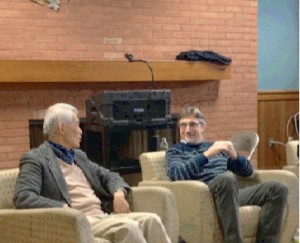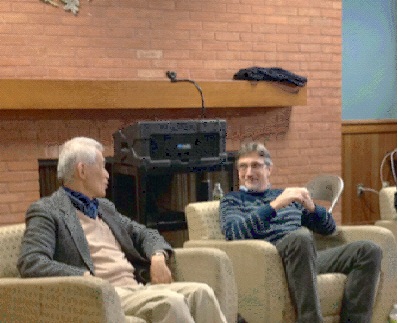Setsuko Thurlow and Yasuaki Yamashita, Japanese survivors of the atomic bombings of Hiroshima and Nagasaki, were joined by the grandson of Harry S. Truman in a lecture at Bucks aimed at limiting global nuclear proliferation.
“People’s hair was standing on end, with burned and blackened flesh swelling twice the size of normal proportions. I remember large portions of skin peeling off and people carrying around their own eyeballs,” Thurlow said in describing the aftermath of the atom bomb being dropped on Hiroshima.
Clifton Truman Daniel is currently compiling first-hand accounts and information from other survivors of the two atomic attacks during World War II.
He is an author, and his current collaboration with nuclear holocaust survivors, known as “Hibakusha,” targets 2014 for a book release containing eyewitness accounts of the attacks on both cities.
Setsuko Thurlow was a 13 in Hiroshima when the atomic weapon nicknamed “Little Boy” was dropped on the city on August 6, 1945.
She recalls the immediate carnage, and the aftermath that followed nearly surpassed the initial death toll as victims were exposed to dangerous and often fatal, radiation levels.
“There was a blinding flash, and the force of the explosion destroyed many buildings. I was aware of a floating sensation, and then I lost consciousness, “she said.
Thurlow continued, “I awoke to darkness and silence, and couldn’t move. A soldier helped me escape the collapsed building; it was on fire and many who could not escape were killed in the fire.”
The collapsed building Thurlow escaped from was 1.8 miles away from the epicenter of the atomic explosion that leveled much of Hiroshima. She credits being inside an army base building at the time of the explosion as just one reason why she is still alive.
Others were not so lucky, many of her classmates among the dead and dying. A rising dust, filled with radioactive particles, formed the telltale mushroom cloud that turned the day to eerie twilight.
Three days later, on Aug. 9, 1945, Yasuaki Yamashita experienced a similar experience on the outskirts of Nagasaki.
As a 6-year-old boy, he admits that at times he did not understand what was happening during the bombing. But what he does recall is at times, horrifying.
“We turned around after a blinding flash, and saw that our house had no windows, no doors, and no roof. Initially, we expected an attack, perhaps some sort of chemical weapon,” Yamashita explained.
Many of the victims not killed in the initial explosion had no idea of the true extent of the attack. They did not know the unseen danger that was just as deadly as the blast, which was the radiation that remained.
The initial explosion was said to have reached nearly 4,000 degrees Celsius. But the radiation left behind continues to harm, and even kill, inhabitants of the area even 67 years later.
The radioactive elements used in the construction of “Little Boy” and “Fat Man” – the bombs dropped on Nagasaki – were plutonium and uranium, respectively.
The radioactive particles released into the atmosphere around these cities have a half-life estimated at nearly 24,000 years. Suffice it to say that the ill effects of these attacks will continue for generations.
Yamashita said, “We sometimes saw children with purple spots on their skin days, even weeks later. We knew the signs that they would soon die.”
Yet in the face of enormous devastation, fire, and radiation, Yamashita and his family faced a more immediate concern following the attack.
“We were starving, moving through the city, unaware of the danger, looking for shelters, or other family who might have food,” he recalls.
“I’ll never forget that wonderful meal we received from the first American soldiers – they gave us dried bread, powdered milk, and raisins.”
Grateful for any sustenance at all, even this rough fare must have seemed like manna from heaven. “I was so young, I didn’t have any animosity at all towards the American GIs,” Yamashita said.
Thurlow was much older and cognizant than the youthful Yamashita and had a differing view.
“It wasn’t until many years later, when I was in college, but yes, I felt it was my moral responsibility to question the use of such weapons against the Japanese people,” she said.
From a much different perspective entirely, author Clifton Truman Daniel joins the survivors in a campaign to spread awareness of past events in hopes of preventing future nuclear conflicts.
As the grandson of then-President Harry Truman, Clifton Truman Daniel has a curious position among the survivors. “I am grateful to be accepted among them, and I plan to continue telling this story to ensure that this never happens again,” he said.
Because he was only 15 when Truman died, Daniel never spent much time talking with his grandfather about the decision to use atomic weaponry for the first time. It is not exactly a topic of conversation to be mentioned over dinner.
But Daniel does recognize that many will question Truman’s fateful decision, and states, “He was just as horrified as everyone else when initial reports of the devastation reached him.”
“That slowly changed over time, and I imagine the more times he was asked about it, the more he got his back up over the issue, and defended his decision more forcefully,” Daniel said.
To be sure, arguments about whether or not atomic weaponry should have been brought to bear in battle, not to mention against a civilian population, will continue to fester as long as the effects of the radiation remain.
Daniel maintains that while his initial reaction was to defend his grandfather’s decision, that the purpose of the series of lectures transcends that need. “This is about healing, about moving forward and not looking backward. We need to prevent this type of attack in the future, since history moves in cycles.”
Thurlow mirrored this notion, saying, “To remember the past is to work for the future. To remember Hiroshima is to work for peace.”
Presently, nine countries worldwide have nuclear weapons. Most of the modern atomic weaponry is far advanced to the initial bombs that devastated Hiroshima and Nagasaki.
Many of the viewers had been previously unaware on what kind of weapons these really were.
Tyler Strauss, 19, biology major from Warminster said, “I was very surprised at not only how strong nuclear weapons are, but also how many countries actually possess weapons of this caliber. Another surprising fact was that every hour, the United States spends about $12 million on nuclear weapons, even though they may never be used again” Strauss continued.
As a final message to the students present at the lecture, Yamashita, Daniel and Thurlow urged greater awareness, and hoped to prompt the younger generation to become more politically active through voting.


